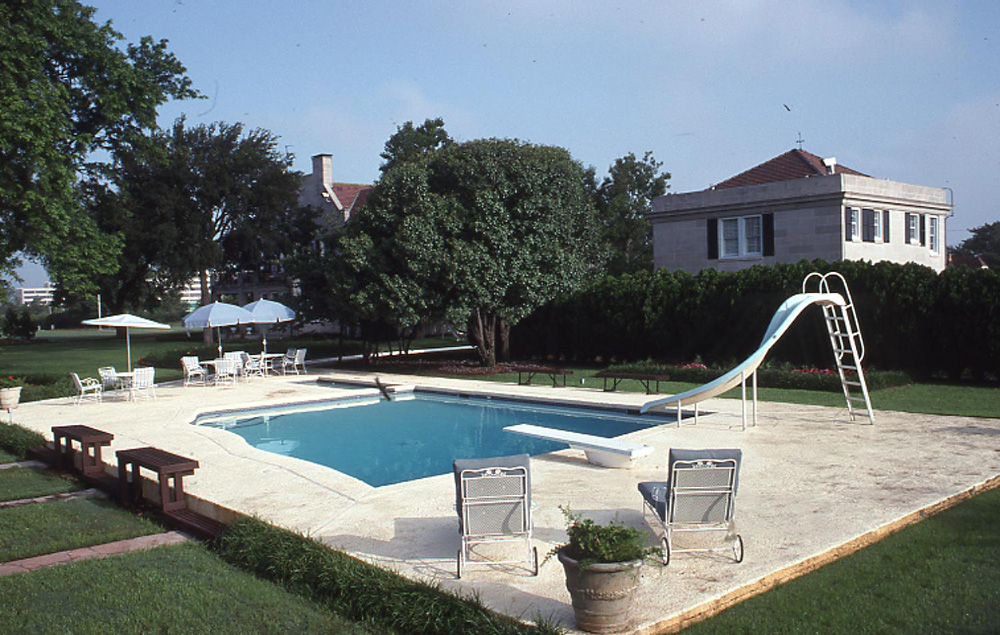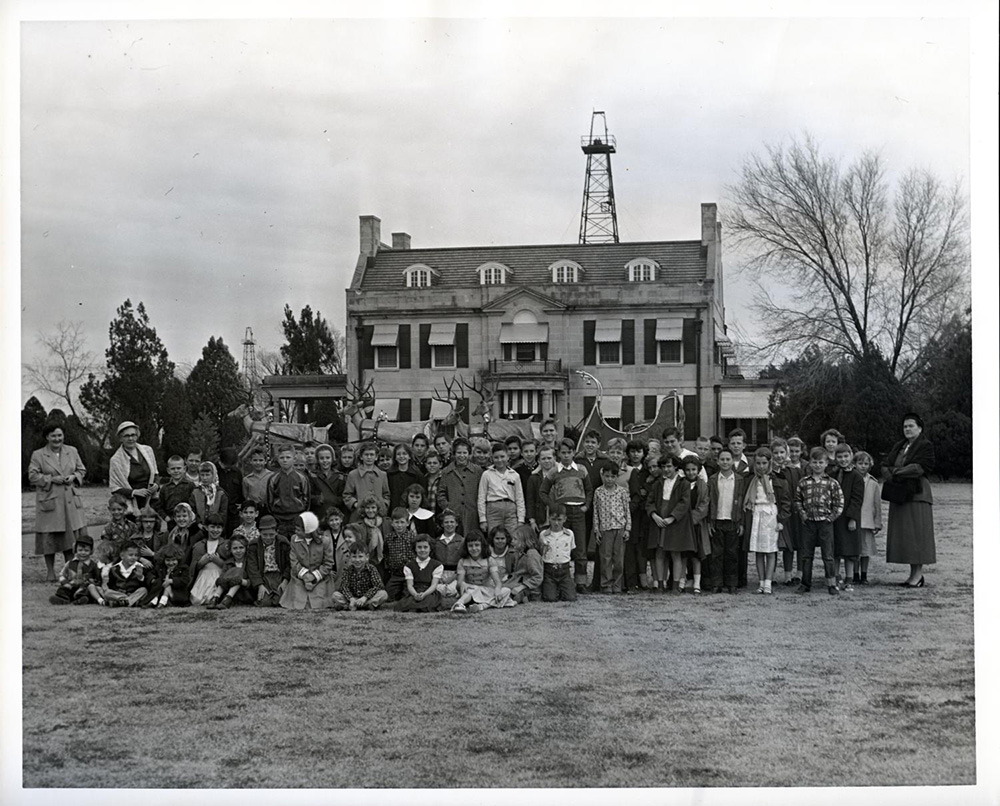A Look Inside (Past & Present)

More than two decades after Oklahoma became a state, the Oklahoma Governor’s Mansion was finally completed in October 1928.

With a limited budget of $75,000, the Mansion was much simpler and smaller than original concepts. Its 14,000-square-foot interior was divided into 19 rooms, including a library, parlor, dining room, grand ballroom, kitchen, sunroom and five bedrooms.

The original Mansion kitchen featured the best in 1928 design, with tile walls, a rubber tile floor and numerous built-ins.

A two-story garage was soon added east of the Mansion, and extensive landscaping was completed in late 1929-early 1930.

In 1931, First Lady Alice Murray invited one woman over 70 years old from each of Oklahoma’s 77 counties to participate in a quilting bee at the Mansion.

After oil was discovered in 1935, Gov. Ernest Marland allowed oil production—despite objections from surrounding residents. During those years, as many as 24 oil wells could be found pumping simultaneously on the Capitol and Mansion grounds.

When Governor & First Lady Murray lived in the Mansion from 1951-1955, the living room featured aqua carpet and Pacific blue walls and drapes. A large, curved sofa (not shown) was upholstered in shrimp pink. Gov. Murray made the nesting tables on the right in his woodwork shop, and First Lady Murray painted delicate flower designs on each.

During the Murray administration in the 1950s, the sunroom was strictly tropical—from its hemp rug to the Philippine rattan furniture. The fragile-appearing draw drapes were actually narrow vertical strips of bamboo adhered to the wall, and the furniture was upholstered in a native flower print against a vivid red background. Throughout the Mansion, First Lady Murray used a deep blue-green shade of paint commonly called “Willie Murray green.”

Guests gathered for one of the weekly open houses hosted by First Lady Willie Murray in the 1950s. Up to 2,000 cookies were baked for the popular event each week, served with coffee in cups stamped “Just Plain Folks.” It is estimated that more than 60,000 Oklahomans toured the Mansion during the Murray administration.

First Lady Jeannette Edmonson enjoyed the newly renovated kitchen in October 1959. After lawmakers resisted funding a complete renovation of the Mansion, hundreds of volunteers pitched in to clean, paint and update the aging residence for newly elected Governor J. Howard Edmondson and his family. The kitchen featured modern cabinets and appliances donated by Dulaney’s in Oklahoma City.

During the Nigh administration in 1979-1987, the formal library was a popular spot in the Mansion for entertaining.

In the 1980s, a swimming pool designed in the shape of Oklahoma was added to the Mansion grounds. A total of $25,000 was donated through private fundraising to construct the pool in honor of the Governor George Nigh and his family.

The Mansion china used during the Bellmon family’s second term (1986-1990) was made by Lenox and featured a gold band and state seal on a cream-colored background. It was paired with gold-plated flatware purchased during the Nigh administration.

The Bellmons chose a statement piece for the Mansion library in the late 1980s: a blue leather couch. Notably, the First Family also reinstalled the original leaded glass doors
on the library shelves.

The Rose Room, also known as the sunroom and Garden Room during previous administrations, was a popular spot for the Walters family in 1990-1994.

In 1991, First Lady Rhonda Walters initiated an extensive renovation of the Mansion—including the kitchen. The kitchen was returned to its original form (and made more functional), with new featured like brick floors, wood inset ceilings, Oklahoma granite counter tops, elegant glass cabinets and all new appliances.

In 1994, Governor David Walters and First Lady Rhonda Walters commissioned the creation of the “Love Always” sculpture, which was installed on the Mansion grounds in honor of the children of past, present and future Oklahoma governors. The statue was created by Lena Beth Frazier, an internationally known Oklahoma sculptor who passed away in 2003.

After Governor and First Lady Keating moved into the Mansion in 1995, they initiated an extensive renovation focused on showcasing Oklahoma history and elegance. In the library (shown), the walnut paneling was re-stained and a sculpture of native son Will Rogers was added to the mantle, among other enhancements.

Under the watchful eye of First Lady Kathy Keating, the Mansion’s Oklahoma Room was renovated in 1995. One feature in the room was a specially commissioned rug showcasing the state seal.

The Mansion dining room was often set for formal dinners during the Keating administration. Among the room’s features were stunning china, silver and stemware selected by First Lady Keating; a chandelier designed by Smileys, Inc., of Sand Springs purchased by First Lady Bellmon to replicate the one used by the Edmonsons; a silver tray given in honor of Governor David Boren; a silver service donated by citizens of Billings to honor the Bellmons; and a Louis XV French armoire donated to Friends of the Mansion by the Noble Foundation.

During the 1996 renovation, the Mansion kitchen was updated with a large commercial oven donated by Oklahoma Natural Gas Company and several new appliances/amenities to make catering for special events more efficient. Another highlight was a 12-burner gas cook top donated by Oklahoma Gas and Electric Company. Food for 12-20 events per week was prepared in the newly renovated kitchen.

In 1996, a replica of the sterling silver punch bowl originally commissioned for use on the battleship USS Oklahoma was unveiled at the Mansion. The original punch bowl, valued at over $600,000 but heavily damaged after decades of use, was placed on display at the Oklahoma Historical Society.

In 2000, a new State of Oklahoma china set was produced by Lenox for the Mansion. The china, designed by Tulsa Porcelain Artist Ronda Renner Roush, is rich with symbolism borrowed from the Osage Shield, a well-known and well-loved “jewel” of Oklahoma heritage emblems. Adopted in 1925, the Osage Shield art honors more than 60 groups of Native American Indians and their ancestors. The china also reflects the Dutch architectural styling of the Mansion, melding Oklahoma symbolism with European refinement and formality.

Oklahomans gathered for Septemberfest at the Mansion in 2003. The annual family festival celebrates Oklahoma’s rich heritage and diversity.

In honor of Oklahoma’s Centennial Year in 2007, a 1907 Steinway Grand Piano (completely refurbished by the Steinway Furniture Company) was purchased and displayed in the Mansion’s foyer. Funding for the historic piece was raised by Governor Brad Henry and First Lady Kim Henry.

In 2007, Governor Brad Henry and First Lady Kim Henry planted an offspring of the Survivor Tree on the Mansion grounds. The iconic American elm tree famously survived the April 19, 1995, bombing of the Alfred P. Murrah Federal Building in Oklahoma City and serves as a powerful symbol of resilience and hope.

In 2017, a beautiful outdoor kitchen was constructed on the Mansion grounds for future First Families, thanks to private funding raised by Governor Mary Fallin and First Gentleman Wade Christensen.

The Mansion library features restored walnut paneling and molding and an impressive collection of works from Oklahoma authors—all displayed behind the original leaded glass doors. The Oklahoma Department of Libraries oversees the Mansion book collection.

In cooperation with the State of Oklahoma, First Lady Sarah Stitt launched an extensive renovation initiative at the Mansion in 2019. In addition to resolving infrastructure issues, the renovations focused on showcasing Oklahoma’s heritage, updating key spaces and incorporating new touches of history.

During the Mansion’s 2020 renovation, First Lady Stitt focused on showcasing the formal dining room’s rich history. Highlights include: the original table bases selected in 1928, the original sideboard, the needlepoint chair covers created in 1972, a handmade wool rug featuring the names of all the Indian tribes of Oklahoma, three original oil paintings from the Oklahoma History Center’s collection, and the Louis XV French armoire and draperies added to the room during the Keating administration.

Many events are held each year in the Philips Pavilion, which was built adjacent to the Mansion in 1998 using private donations. The spacious facility features twin fireplaces, a commercial kitchen and all the necessary furnishings, equipment and more for small and large functions.

An aerial view of the Mansion buildings and grounds, which are preserved and maintained by the Friends of the Mansion.

The Rose Room received special attention during the 2020 Mansion renovation. First Lady Stitt enhanced the room’s panoramic views of the Mansion grounds and the Capitol dome by exchanging arched windows for the original rectangular ones and minimizing window treatments. The room offers an intimate space for meetings and luncheons hosted by the Governor, and its English-country look and vibrant wall color reflect the spirit of its name.



